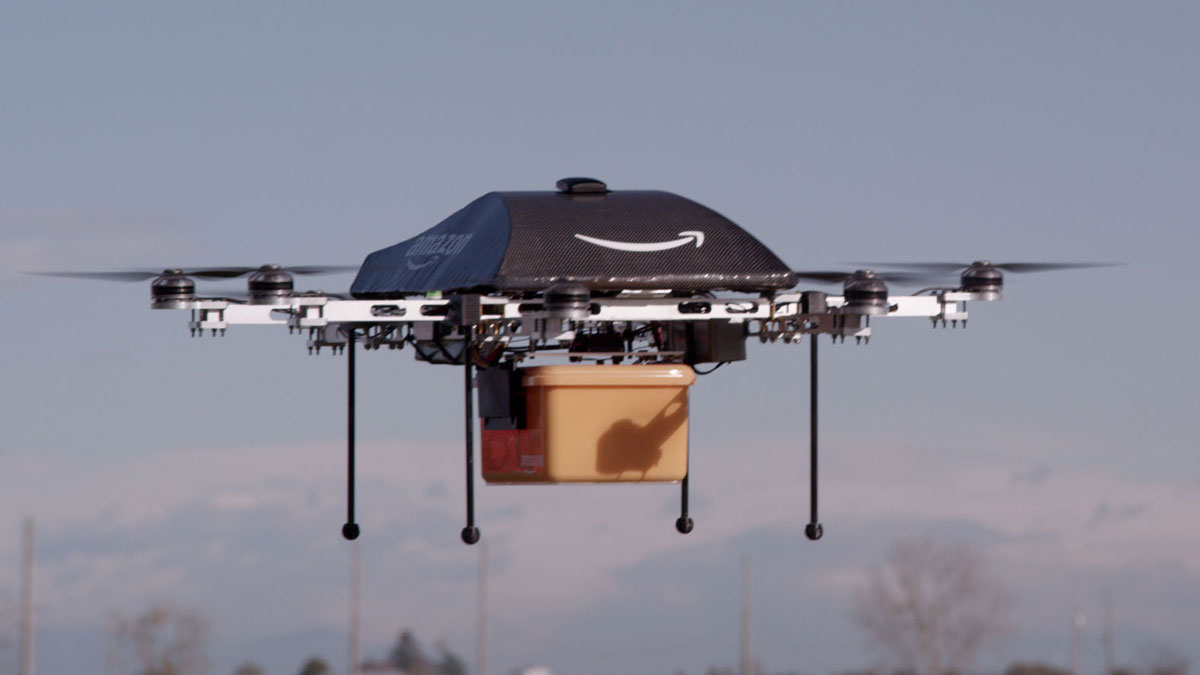
If, like us, you work in central London, you probably think UK airspace is crowded enough. Every day, dozens of helicopters, jumbos, military vehicles and other craft fly overhead. Look at any corner of the sky, and you’ll see a plane.
Most of these craft are high up enough to be relatively unbothersome. But how would our environment feel – how would our day-to-day be affected – if vehicles like those were flying just a few hundred feet above our heads?
Well, we’re about to find out. Sort of.
For the first time, a government team supported by the Civil Aviation Authority (CAA) has given its permission for a company – Amazon – to explore three key areas of innovation: “beyond line of sight operations in rural and suburban areas, testing sensor performance to make sure the drones can identify and avoid obstacles, and flights where one person operates multiple highly-automated drones”.
Taken together, those tests give us some sense of how delivery drones would operate. A small number of operators would oversee a large number of near-autonomous drones, trained to avoid obstacles in order to avoid causing damage to people, buildings or nature. These drones would fly beyond the eye-line of their masters.
Clearly, this requires quite serious engineering and AI know-how. Many people will be sceptical about these drones’ ability to operate safely – and therein lies the greatest challenge for Amazon and other companies looking to cut the human element out of parcel delivery: social stigma.
Drones have a reasonably bad rep – deservedly so. Almost all the news we hear about them is negative. “Drone successfully flown from one end of field to another” is not a news story; “Drone hits British Airways plane” is.
People are inherently conservative; if a technology makes only a marginal change to their life, and comes with an element of risk, they’re likely to reject it. In the same way that autonomous car headlines focus on a handful of crashes (rather than millions of miles of safe journeys), drone coverage discusses the potential risks of the technology, not its boons.
How important is drone delivery?
Amazon’s UK drone trial is aimed at assessing the viability of 30-minute drone delivery. In a world where Amazon Prime already exists – and parcels can be delivered within a day – how much difference does that sort of speed make? It’s marginal.
At first – and probably for a good while – drone delivery is likely to be expensive (if it is ever approved). I think it’ll take quite some time for automated delivery to take even a small chunk out of the online delivery market. Most deliveries just aren’t urgent enough to pay much more for. How often do you send a letter by recorded delivery (and how much do you resent doing so)?
Drones face issues of price and utility – and that’s before they’re even allowed to fly. If Amazon passes this trial, it will only tick off the last of those three issues. Still, convincing a government agency that drones are safe to fly in urban areas will probably have a strong trickle-down effect on public opinion of drones. That goes hand in hand with government approval – that’s what makes this trial so crucial for Amazon.
Starship Technologies, the company behind the cute six-wheeled delivery bot Starship One, knew just how crucial likeability was to their company’s success. It’s no coincidence their robot looks quite so unthreatening, nor that its designed to move in pace with the average human pedestrian. Most people, reports say, don’t even notice the little boxes on wheels. The ground-based bots are utterly unthreatening – and they do the same job as drones would.
I’m excited to see the results of the Amazon/CAA trial, but even a flawless success would not mean a drone above every street. The public perception of airborne drones is just too negative – and those perceptions aren’t going to change by brute force.